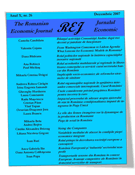Abstract:
This paper empirically examines the relationship between the key banks' specific variables of regression models in determination of bank profitability in Bosnia and Herzegovina (B&H). For the purposes of econometric modeling, quarterly indicators of the banking sector based on country's aggregate data over the period 2000q1 to 2014q2, including one macroeconomic indicator (GDP growth rate) were employed. The key findings of this research showed that there was a positive and statistically significant relationship between (ROAA), the three of explanatory variables (LATA, TLTD and CRR) and a negative and statistically significant relationship with CEF and CAR. The results of our study have shown that higher bank's profitability measured by ROAA was possible if the banks increase the employment of capital, effectively manage operating costs, increase the share of deposits in financing loans, and improve non lending operation. More specifically, ROAE was significantly influenced by only two variables: cost efficiency and management of credit risk. Our findings of Model 2 and statistically insignificant relationships of six explanatory variables with ROAE can be explained by the consequences of global financial crisis. This influenced the profitability since more economic factors were affected abnormally during analyzed periods. The paper is structured as follows: Section 2 deals with the literature review; Section 3 contains an explanation of the data and methodology and Section 4 deals with empirical findings. The findings and discussion presented in previous sections of this paper end with conclusions in section 5.
